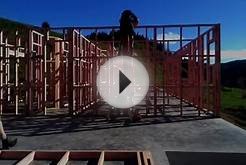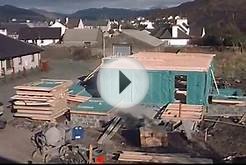This advice applies to Scotland only Get advice if you're in England.
The process for buying a new build home is slightly different from the process for buying a older home, especially if building work on the property is not yet finished. This page looks at how the process works and what you can do if you're not happy with your new home.
First steps
If you are interested in buying a new build home, you will first need to:
- find out how much you can afford to pay
- choose a mortgage and a mortgage lender
- appoint a solicitor.
The pages on arranging a mortgage and finding a solicitor explain more about this.
Advantages
New build properties have several advantages over older homes. For example:
- everything in it will be brand new
- you are unlikely to need to carry out any repairs or decoration work for a few years (in fact it's advisable not to decorate in the first year, as your home will need this time to dry out and settle)
- new build homes are more energy efficient
- fire safety standards are high
- most come with a warranty, which insures the house against structural problems for ten years (see 'warranties' below)
- you may have the opportunity to select the flooring, the fittings for the kitchen and bathroom and the décor for the home
- you may be able to negotiate with the seller to get free carpets, curtains or other fittings
- you may not have to pay stamp duty - some developers will pay this for you
- some developers offer additional incentives, such as cashback, discounted mortgages, part exchange on your old home and help to pay your deposit or legal fees.
Disadvantages
Potential problems with buying a new build home include:
- delays in the completion of the home - check the conveyancing section for including completion dates in your agreement with the developer.
- unsatisfactory building, plumbing and electrical work
- difficulties in getting faults put right - for these first three issues you should think about warranties or insurance to make sure your property meets certain standards and give you redress with your developer. See the warranties section below for more details.
- the possibility of living on a building site until the whole development is finished.
Finding a new build home
When looking to buy a new build home, you may consider:
- buying a new home that is already completed
- buying a home that is in the process of being built
- buying a home before it has been built - this is called buying 'off plan' (see below).
You can find out about new build homes in your area:
- in newspaper property guides
- in listings papers issued by solicitors' property centres
- directly from the building companies.
You can also search for local developments in your area at the following websites:
Buying 'off plan'
If you buy off plan, you are buying a home that has not yet been built. You will be shown a developer's brochure containing photos of similar properties and floor plans for the home, and you will be able to reserve the plot of land where it will be built.
This can save you a lot of money if house prices rise between the time you decide to buy the home and are given a price, and the time you actually move in.
The disadvantages are:
- the home may not live up to your expectations once it is built (see 'what if I'm not happy with my new home' below)
- the value of the home may go down depending on the current market.
Viewing new build homes
If you're interested in buying a new build property, your first step is often to view a show home. As you're looking round, ask the sales representatives as many questions as you can about the home, the development and the local area. The Shelter Scotland home buyer's checklist suggests things you should look out for when viewing properties, and you can use it to see how well properties measure up to your requirements.
In addition:
- Take a look around the development site. Is it tidy and well managed? If so, this suggests that the developers are well organised and professional.
- Talk to other people living on the development. Are they happy with their homes? If no-one has moved in yet, try to contact people living in other developments by the same company.
- Find out if the developer has any plans for the surrounding area and what the timescale is. Do you want to live on a building site for the next five years?
- Check out the local amenities carefully. Some new build developments can seem isolated from the surrounding area, lacking convenient shopping, public transport and entertainment facilities. Other developments may come complete with shops, a playground or crèche, a GP's surgery or health centre and other community services.
Warranties
It's important to check that the property comes with a warranty. Some mortgage lenders won't lend you any money unless the home has a warranty, although others may be satisfied with a certificate of completion from the local council (see below).
What is a warranty?
This is a guarantee issued by an insurance company that proves that the home reaches safe construction standards. It also covers you if the developer goes out of business, by either refunding your deposit or paying to complete the property. The warranty offers insurance for the developer rather than consumer protection for you, but it's still important that the home has one.
Warranties last for ten years. For the first two years, the developer is responsible for putting right any faults covered by the warranty. After that, you will have to make a claim to the warranty provider. Only structural problems are covered by the warranty.
Who provides warranties?
The best known warranties are:
What if the home doesn't have a warranty?
All new build homes must have a completion certificate issued by the council's building control department. This shows that the property has been inspected by a representative from the council and that it complies with building regulations. To check whether a new property has a completion certificate, contact your local building control office. Your council's website should have contact details.
Making an offer
Once you've found a property you like, you'll need to arrange a formal mortgage offer with your lender. Make sure you check with the lender whether the home needs to have a warranty, or whether a completion certificate from the council is enough. This will vary from lender to lender.
You'll then be ready to put in an offer. New build homes are usually sold for a fixed price. However, you may be able to negotiate a good deal on extras such as kitchen and bathroom fittings and floorings, especially at the end of the developer's financial year. Make sure you get any extras confirmed in writing.
Conveyancing
Once your offer has been accepted, your solicitor can finalise the sale with the developer. They will need to check that:
- the local council are not planning any repairs or developments which could affect your property, for example, a road widening scheme
- responsibility for maintaining any communal areas of the property (for example, the stairwell, roof or garden) is jointly held by all residents
- there are no problems with access to the property (for example, your solicitor will need to check that the access road is maintained by the council, and doesn't belong to a private owner)
- there are no restrictions to your ownership (for example, rights of way through the garden)
- the boundaries of your property are clearly defined (this will avoid disputes with your neighbours over hedges, driveways, parking, etc).







